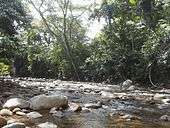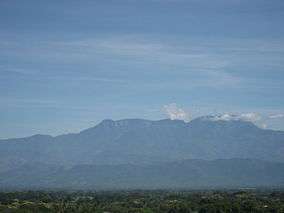Sierra de Perijá National Park
| Sierra de Perijá National Park Perijá National Park | |
|---|---|
|
IUCN category II (national park) | |
|
Perijá National Park | |
 Location in Venezuela | |
| Location | Venezuela |
| Nearest city | Maracaibo |
| Coordinates | 9°32′0″N 73°0′0″W / 9.53333°N 73.00000°WCoordinates: 9°32′0″N 73°0′0″W / 9.53333°N 73.00000°W |
| Area | 295,288 hectares (729,670 acres) |
| Established | 1978 |
| Governing body |
Instituto Nacional de Parques(INPARQUES) ’’National Park Institute’’ |
Sierra de Perijá National Park, also known as Perijá National Park, is a protected area in Venezuela. It is located in the Serranía de Perijá mountains on the border with Colombia,[1] to the southwest of Zulia state and Lake Maracaibo. The park was established in 1978 with the objective of protecting the hilly regions.[2]
Geography

Sierra de Perijá National Park is situated in the Perija and Colon municipalities of Zulia State. The park is accessible by road from Maracaibo.[1]
The park includes a portion of the Serranía de Perijá mountains,[3] which rises above the southwestern area of Lake Maracaibo, a large brackish bay connected to the Gulf of Venezuela. The highest elevation is Pico Tétar at 3,500 metres (11,500 ft).[1] It covers an area of 295,288 hectares (729,670 acres).[4]
Flora and fauna

The vegetation in the park consists mainly of rainforest, cloud forests, highland moors and sub-alpine and alpine tundra.[1] Some typical trees include Anacardium excelsum, wax palms Ceroxylon, Cecropia, Gyranthera caribensis, Tabebuia chrysantha and Podocarpus oleifolius and there are many herbs, flowering plants and bromeliads.[5]
The wildlife in the park includes spectacled bear, as well as capuchin and howler monkeys.[1] Dolphins in Lake Maracaibo are proposed to be brought under a protection programme through the South American River Dolphin Protected Area Network .[2]
Birds include parrot species such as the endangered military macaw (Ara militaris) and the great green macaw (Ara ambiguus).[6] Another endangered bird species found in the park is the Perija Metaltail hummingbird (Metallura iracunda).[7] It is also the habitat for another hummingbird, Coeligena consita, an endemic species of the Sierra de Perijá found on its southern slopes.[8] A newly discovered species of tapaculo found in the park is the Perijá tapaculo (Scytalopus perijanus) which was first described in 2015.[9]
References
- 1 2 3 4 5 "Perijá". think-venezuela.net. Retrieved 1 September 2015.
- 1 2 Hoyt 2012, p. 240.
- ↑ Dallmeier & Cringan 1989, p. 300.
- ↑ "National Parks of Venezuela". World Institute for Conservation & Environment. Retrieved 1 September 2015.
- ↑ IUCN Directory of Neotropical Protected Areas. IUCN. 1982. pp. 381–. ISBN 978-0-907567-62-2.
- ↑ "Endangered and Threatened Wildlife and Plants; Two Foreign Macaw Species". Federal Register: Daily Journal of the United States Government. Retrieved 1 September 2015.
- ↑ "EN:Perija Metaltail Metallura iracunda". Birdlife International. Retrieved 1 September 2015.
- ↑ "VU:Perija Starfrontlet Coeligena consita". Birdlife International. Retrieved 1 September 2015.
- ↑ "Perijá Tapaculo: New Bird Species Discovered in Colombia, Venezuela". Sci-News.com. 12 March 2015. Retrieved 1 September 2015.
Bibliography
- Dallmeier, Francisco Gomez; Cringan, Alexander T. (1989). Biology, Conservation and Management of Waterfowl in Venezuela. Editorial Ex Libris. ISBN 978-980-6200-13-5.
- Hoyt, Erich (2 October 2012). Marine Protected Areas for Whales, Dolphins and Porpoises: A World Handbook for Cetacean Habitat Conservation and Planning. Routledge. ISBN 978-1-136-53830-8.
External links
 Media related to Sierra de Perijá National Park at Wikimedia Commons
Media related to Sierra de Perijá National Park at Wikimedia Commons
| ||||||||||||||||||||||||||||||||
